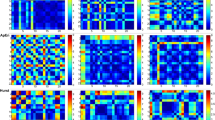Abstract
The localization of the epileptogenic zone (EZ) is crucial for the successful surgical treatment of epileptic patients who suffer from drug-resistant epilepsy. In this paper, we propose a new approach for EZ localization. The partial directed coherence approach and the outstrength parameter derived from graph theory are used to characterize the synchronization and desynchronization properties of brain structures and to categorize the corresponding channels into three groups referred to as the onset group, early propagation group and late propagation group according to their involvement in the seizure progress. Our results prove the effectiveness of the proposed approach, which corroborates the clinician’s visual inspection and makes it possible to identify a set of channels that delimit the epileptogenic zone. The proposed approach for EZ localization can be considered a valuable tool for the successful surgical treatment of epileptic patients that suffer from the type of epilepsy considered.


Similar content being viewed by others
Data availability
The data used to support the findings of this study are restricted by the CHU (Centre Hospitalier Universitaire), Rennes, France in order to protect patient privacy.
References
Epilepsy—World Health Organization. http://www.who.int/news-room/fact-sheets/detail/epilepsy (2019)
Mahjoub, C., Chaibi, S., Lajnef, T., Kachouri, A.: Classification of epileptic cerebral activity using robust features and support vector machines. In: IPAS 2016—2nd International Image Processing, Application and Systems Conference, pp. 1–6 (2016)
Mahjoub, C., Le Bouquin Jeannès, R., Lajnef, T., Kachouri, A.: Epileptic seizure detection on EEG signals using machine learning techniques and advanced preprocessing methods. Biomed. Tech. 65(1), 33–50 (2020)
Mahjoub, C., Chaibi, S., Krikid, F., Nica, A., Le Bouquin Jeannès, R., Kachouri, A.: Epileptic seizure detection using multivariate empirical mode decomposition and support vector machines. In: IEEE International Conference on Design and Test of Integrated Micro and Nano-Systems (2020)
Orosco, L., Correa, A.G., Laciar, E.: Review: a survey of performance and techniques for automatic epilepsy detection. J. Med. Biol. Eng. 33(6), 526–537 (2013)
Correa, A.G., Orosc, L.L., Diez, P., Leber, E.L.: Adaptive filtering for epileptic event detection in the EEG. J. Med. Biol. Eng. 39, 912–918 (2019)
Mohammadi, M., Pouyan, A.A., Khan, N.A.: Automatic seizure detection using a highly adaptive directional time: frequency distribution. Multidimens. Syst. Signal Process. 29, 1661–1678 (2017)
Atal, D.K., Singh, M.: A hybrid feature extraction and machine learning approaches for epileptic seizure detection. Multidimens. Syst. Signal Process. 31(2), 503–525 (2020)
Fisher, R.S., Webber, W.R.S., Lesser, R.P., Arroyo, S., Uematsu, S.: High-frequency EEG activity at the start of seizures. J. Clin. Neurophysiol. 9(3), 441–448 (1992)
Bartolomei, F., Chauvel, P., Wendling, F.: Epileptogenicity of brain structures in human temporal lobe epilepsy: a quantified study from intracerebral EEG. Brain 131, 1818–1830 (2008)
Nair, D.R., Mohamed, A., Burgess, R., Lüders, H.: A critical review of the different conceptual hypotheses framing human focal epilepsy. Epileptic Disord. 6(2), 77–83 (2004)
Wendling, F., Chauvel, P., Biraben, A., Bartolomei, F.: From intracerebral EEG signals to brain connectivity: identification of epileptogenic networks in partial epilepsy. Front. Syst. Neurosci. 4(154), 1–13 (2010)
Rubinov, M., Sporns, O.: Complex network measures of brain connectivity: uses and interpretations. Neuroimage 52(3), 1059–1069 (2010)
Varotto, G., Tassi, L., Franceschetti, S., Spreafico, R., Panzica, F.: Epileptogenic networks of type II focal cortical dysplasia: a stereo-EEG study. Neuroimage 61(2012), 591–598 (2012)
Bullmore, E., Sporns, O.: Complex brain networks: graph theoretical analysis of structural and functional systems. Nat. Rev. Neurosci. 10(3), 186–198 (2009)
Wang, H., Hernandez, J.M., Van Mieghem, P.: Betweenness centrality in a weighted network. Phys. Rev. E 77(40), 1–10 (2008)
Li, Y.H., et al.: Localization of epileptogenic zone based on graph analysis of stereo-EEG. Epilepsy Res. 128, 149–157 (2016)
Alarcon, G., Binnie, C.D., Elwes, R.D., Polkey, C.E.: Power spectrum and intracranial EEG patterns at seizure onset in partial epilepsy. Electroencephalogr. Clin. Neurophysiol. 94(5), 326–337 (1995)
Wetjen, N.M., et al.: Intracranial electroencephalography seizure onset patterns and surgical outcomes in nonlesional extratemporal epilepsy. J. Neurosurg. 110, 1147–1152 (2009)
Bartolomei, F., et al.: From mesial temporal lobe to temporoperisylvian seizures: a quantified study of temporal lobe seizure networks. Epilepsia 51(10), 2147–2158 (2010)
Baccalá, L.A., Sameshima, K.: Partial directed coherence: a new concept in neural structure determination. Biol. Cybern. 84(6), 462–474 (2001)
Qi, X., Fuller, E., Wu, Q., Wu, Y., Zhang, C.Q.: Laplacian centrality: a new centrality measure for weighted networks. Inf. Sci. 194, 240–253 (2012)
Acknowledgements
The authors wish to thank Isabelle Merlet, Researcher at Inserm, for her very fruitful discussions. The research reported in this paper was developed as a part of a PHC (Partenariat Hubert Curien) Project CREDIADIC n°41711PK, CMCU Code 19G1411.
Author information
Authors and Affiliations
Corresponding author
Ethics declarations
Conflict of interest
The authors declare that there is no conflict of interest regarding the publication of this paper.
Ethics approval
All experimental procedures have been conducted at the CHU (Centre Hospitalier Universitaire), Rennes, France, following the ethical and regulatory standards. The patient has signed a consent and has been informed that his iEEG data would be used for clinical research and might serve for publication.
Additional information
Publisher's Note
Springer Nature remains neutral with regard to jurisdictional claims in published maps and institutional affiliations.
Supplementary Information
Below is the link to the electronic supplementary material.
Rights and permissions
Springer Nature or its licensor holds exclusive rights to this article under a publishing agreement with the author(s) or other rightsholder(s); author self-archiving of the accepted manuscript version of this article is solely governed by the terms of such publishing agreement and applicable law.
About this article
Cite this article
Mahjoub, C., Chaibi, S., Nica, A. et al. Epileptogenic zone localization based on partial directed coherence and graph analysis: a case study. SIViP 17, 955–963 (2023). https://doi.org/10.1007/s11760-022-02299-9
Received:
Accepted:
Published:
Issue Date:
DOI: https://doi.org/10.1007/s11760-022-02299-9




